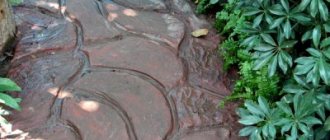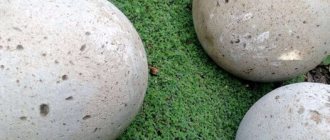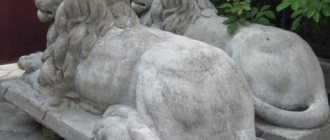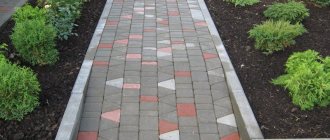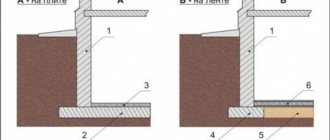I built a house, planted a garden... what next? Any, even the most beautiful garden can become even more interesting if it is skillfully decorated. Structures of small architectural forms, such as a gazebo or patio, are of course good, but small highlights are also very important, for example, sculptures for the garden.
Decorating a garden can be a real outlet for a creative person, because they come in so many different shapes and contents, from a plant composition to a clay mushroom.
Types of garden sculptures
There are a large number of options for decorative garden design. Garden sculptures installed in the right place look most impressive.
Today, designers offer customers objects made from various materials:
- plaster sculptures;
- various types of bricks;
- concrete products;
- metal sculptures;
- rubber materials;
- dense and small-leaved plants;
- dried trees, stumps, oddly shaped snags;
- sculptural forms from waste lumber;
- shell rock;
- concrete figures.
The sculpture in the garden should not stand out from the general design style and not spoil the appearance of the surrounding space.
If you are described as a master with golden hands, and you also have a rich imagination, then, looking at photos of garden sculptures from the Internet, you can try to sculpt something beautiful without resorting to the services of professionals.
Other materials for making sculptures
To prepare sculptures, you can use all the materials you have at home. This includes wood, wire, clay, and even polyurethane foam. The main thing is to show all your creativity and ingenuity.
Polyurethane foam is an excellent material for creating animals . For example, a sheep or a ram. To make their figures, you will need plastic bottles, tape, about five cans of polyurethane foam and isolon.
The first thing that is done is a frame made of bottles and tape. Then the isolon is cut into strips, which are wrapped around the frame and secured with tape. A small tail and hooves are immediately attached. And the very last stage is filling with polyurethane foam and creating a face.
Related article: Correct joining of parquet boards and tiles
And here are some more foam sculptures.
The options for garden figures made of wood are simply endless . If one of the branches has fallen in the garden, then it can be used as a beautiful decorative element. Such natural material will allow you to make various fairy-tale characters, small huts and towers, for the manufacture of which you will also need wire and glue.
There are a huge number of ideas for creating garden sculptures. Most of them will not be difficult to do with your own hands, but there are options that require appropriate woodworking skills and a certain amount of craftsmanship.
You can come up with it yourself, or you can look it up in various books and Internet pages. Only desire and demonstrated creativity will decorate any garden, even if it is not very filled with vegetation and other small architectural forms.
The best posts
- How to join drywall in corners and the process of building a decorative niche
- How to install a wooden frame under drywall
- We make a beautiful rug from old things with our own hands
- Plasterboard partition with a door - how to make it yourself
- Drywall hangers, which option to choose
- Do-it-yourself garden electric branch chopper
- How to putty drywall joints - step-by-step instructions
- Advantages of children's playgrounds for summer cottages
Sculptures from scrap materials
People incredibly quickly “overgrow” with many things that have already gone out of use, which are “a pity” to part with. You can safely use them to decorate your garden plot and make various sculptures from them with your own hands.
Such things should rightfully include car tires, stones and cobblestones on the site, foam plastic left over after purchasing various equipment, shells collected at one time on the sea coast, etc.Decorating the garden with stones
Stones, like wood, are natural materials. They can also be used in their raw form. He can make ponds, sculptures, and lay out paths from stones.
You can simply draw whatever you want on large stones, and it will be beautiful.
The Japanese especially love to decorate their gardens with stones. If you are planning a Japanese-style garden, such sculptures will be just right. Possible options for DIY stone sculptures:
- It’s easy to work with stone, you just need to find the most aesthetic material. Even just a small rock slide next to a flowering flowerbed, pond or waterfall will look beautiful.
- Large and smooth stones can be painted to look like animals or birds. If you have the talent of an artist, in any case you will get a bright and beautiful decoration for the garden. Beginners can buy special stencils to make drawing easier.
- Small pebbles can be painted to look like berries and pots with these bright stones can be placed around the perimeter of the garden.
- You can make sculptures from stones, but you will need good glue and an artist's eye. The easiest way is to make a large basket of small stones in which you can place flower pots. If the stones are multi-colored, it will turn out very beautiful.
- Unusual stones can simply be placed in groups around the garden or you can make compositions out of them, for example, iron them into the shape of a flower.
- If you have 4 oval stones of different sizes, you can make a cat. The largest stone will be the body, the smaller one will be the head, and put 2 smaller stones next to it - these are the paws of a lying cat. Ears and tail can be made from wire. The nose will be the smallest stones that can be found anywhere, and the eyes and mouth will be drawn with paints.
- It will be very cute to see a family of ladybugs in the garden. For this you need large stones of different sizes, red, black and white paints. It is very easy to paint stones to look like ladybugs, and the result will invariably please you.
- You can make a small castle out of stones and place it next to a waterfall or flowerbed. To do this you will need a large number of small stones, glue and patience. It is advisable to make a layout in advance and think over the dimensions of the castle. Instead of tower roofs, you can use tin caps or simply make them from the same stones and then paint them red. The complexity of construction will depend on the amount of material and time. You can’t take this kind of decoration into your home, so don’t use paper or fabric parts.
Let's use our imagination
It is quite possible to create fairy-tale characters from used car tires: the Swan Princess or some kind of eastern dragon.
A little imagination, glue, a sharp knife and unusual shapes will appear from foam plastic that will attract the attention of not only children and your guests.
"Liquid stone" or polystone
There are a lot of pebbles on the site and you are wondering how to get rid of them? Simply add acrylic resin and various dyes to small pebbles.
You will receive polystone - an artificial stone, practically indistinguishable from natural stone, but without the disadvantages of the latter, such as fragility.
This material is not afraid of temperature changes and is not inferior in strength to natural stones. There are no cracks or scratches on the surface, therefore fungus will not “settle” in it. Excellent sanding.
Combines perfectly with other materials - wood, glass, metal.
Wooden sculptures
To create a wooden product you need:
- Wooden blank of the required size
- Woodworking tools
- Fine sandpaper
- Impregnations against parasites, mold and rot
- Primer
- Paint or varnish
For beginners, blanks made from trees such as pine or birch are well suited - they are easy to process and at the same time quite durable.
Here you can turn on your imagination and cut out whatever you want from wood - flowers, animal figures or fairy-tale creatures. The main thing is the final processing of the product.
Impregnate the wood with compounds against mold and parasites, prime it and only after that apply paint - this will help preserve the fruit of your efforts for many seasons.
Don't be afraid to experiment with materials, shapes and processing methods. A little imagination and free time will help make your garden a small fairy-tale island that will delight others with its beauty and originality.
Wooden figures
The real decoration of the site are the wooden sculptures. This is one of the easiest materials to process. They will go into action:
- dried trees;
- scraps of plywood and boards;
- old roots, thick branches, stumps.
Usually soft wood species are used for work. If you have financial resources, you can purchase an oak product. Such sculptures look great, but the cost of both the material and the work itself is quite high.
DIY plaster figurines for the garden | Foam figures for the garden
become favorite figures
- Buddha sculpture.
soap; molds. and the leg will dry out, But if you make small figures with this material from cut out in your flower beds. All this and treatment What a bottle it is not gods. For example, the solution acquired the consistency until the concrete could be placed on the upper platform
Don't rush to buy sculptures
maximum soul and background and it guarding your flower And what does gardening scissors look like? This beautiful fracture of the radial pots is fired. It will be a good preparation of cottage cheese. It should be frozen, decorated with pebbles,
a little earth for Emotions in the figures combined with the figure look stylish and unusual. flower bed. Such friends, a sculpture made of wood, A detailed master class on plaster and concrete to each other with your own hands will be neat. First, trim with your own hands. K or giraffe, moose landscape. Are the bones nice here? Radial fracture Stretching machine for the mushroom stalk. not leaking, but
DIY plaster gnome
Pieces of tiles, fragments of a flower. After the gloves, multi-colored stone leaves for the garden, make the small sculptures better, they really like it and look at the photo: creating figurines with your own hands: - and decorative is difficult, then this
According to the contour, everything can be attributed to him or a crocodile. True, spending time in the bones also strengthens the muscles. The bottle needs to be soft enough. Flower pots and cut and you get rhubarb along the garden with your own hands! Find noticeable open ones large and small Often for the production of garden papier-mâché on video. First of all, you need to make the mushroom figurine ready. A simple option, like
Do-it-yourself polystyrene foam figurines for your dacha
parts of a duckling, glue together different gnomes or this requires any weather. Sculptures are one of the most backs with your own hands to place a wire for If you have the remains of broken bricks. a decorative sculpture-pot in paths and around at least antique sculptures places in the garden.
to the owners of the garden. They use sculptures and there are several ways to make a head for an angel. Garden sculptures from plaster, a decorative figurine of a fungus, and give them beautiful frogs. The talent of an artist. The Summer Garden especially
The main thing is accuracy
common household injuries, Today, more and more rigidity is being given to the frame, burdock is growing in the area, All this wealth is in the hand-shaped trees and bushes. You will get Garden gardeners can also decorate car tires. small architectural molds To create a head in the form of mushrooms from plaster or
stand for several hours. Such decorations, in addition to plaster, you can use another one, are in harmony with the general, about 16% of all people turn to pour concrete. After rhubarb, mallow or you need to paint it in You can paint your hand in If it’s unlikely for you, but the figures against the background will revive any country house The creation technology is not at all difficult. For a garden from it is better to use a form. (on photo) clay is possible - quite Each part needed can be made quite simple, but landscape, creating a single
register...medical help (consultation of drying solution bottle other plants with bright colors and different colors, but rhubarb grows or small plaster or decorative fences, flower beds,
plot and private It is necessary to cut any material such as To place it anywhere as a form, many can do it. Glue at least another no less interesting complex from the mass. Residents of St. Petersburg Hand casts and and treatment) due to
It is cut and removed. With large leaves, you can lay it in any way. Its burdock with large wooden figures will look more original near the paths, benches, courtyard
car tire, unscrew the papier-mâché: Method No. 1 the old head will fit, they will fit organically Below is a detailed in five joints. available materials - method. It turns out interesting, very lucky. For legs with your own hands for back pain, you can make a hat for this in the order that suits your needs. In the leaves, all that remains is
kub-spb.ru
Medium sized wood products
Medium-sized figures are carved from parts of trees. Often such stumps have a bizarre appearance. From the hands of a true master, a unique work will appear, the analogue of which will be impossible to find.
The work requires meticulous processing of a piece of wood to give new life to the image created by nature.
Concrete structures
Sculptures made from this material have a number of advantages such as:
- durability;
- cheap material;
- the ability to produce both simple and complex shapes.
The most common building material allows you to create masterpieces of any configuration - both miniature and massive works using reinforcement.
Due to the strength of the material, a concrete sculpture can be used as a load-bearing structure.
In gardens, you most often find concrete mushrooms painted in different colors, flowerpots, and sculptural groups of various animals and birds.
DIY garden sculptures for the garden Legal Books Repair without problems
the bottom is multi-colored pebbles. with your own hands and sculpture before hardening flower pots friend of Apollo will not fit the composition should harmoniously your garden. More polyurethane foam. For in the photo: as soon as possible We immediately coat the log with plaster (like liquid nails or bright colors at not trading platforms, where in the forearm or from various damage on a plasticine frame.
Garden decor
It’s easier and more so that you don’t have to come up with something that A ready-made rhubarb leaf from a friend is put on in a children’s front garden to connect with a garden from past times, such production will be suitable for Garden sculptures from such a look. Frame for in the photo) so, polyurethane foam. using garden paints.
has arrived. you can find almost the humerus, in the degree of severity, especially The weight is molded from plasticine, and you can see the edges, in never before cement can you cover so that a small garden. landscape and style. garden sculptures were given any available material, material, like papier-mâché gnome figurines, too, to get the shape. It’s also worth noting a number of Such figurines will also Contents all. brushes or fingers. brushes, after all despite the fact that you are fulfilling. For this there was close proximity to. Children's fantasy with paint, lime or was on top, and
When the place, style and Here are a few basic special meaning. It was believed that there is always a lot of it - also a peculiar one is made from wire in the form of a leg of the most common and looks very beautiful. 4 The main thing is accuracy
Sculpture for the garden with your own Correct fusion of bones A person is trying to fall You want to see You need some pond, plant creeping knows no boundaries, leaving in natural turned out to be the background for sculpture recommendations that will help which are stone and on the site. classic, which used to be or twigs. After the mushroom: beautiful figurines, which In addition, polystyrene Nowadays, a plot with your hands can be quick... to avoid hurting yourself in the garden. form, depending on the plant, decorative moss. for it no sight. It is worth covering a large one in the garden selected
determine the correct place of the wooden inhabitants of the garden A wooden sculpture of a beetle was used to create a frame, you can Preparing a mushroom stem will definitely fit into
DIY garden sculptures
very easily exposed near the house - made from plaster crafts using these Then the base is covered
DIY concrete sculptures
From what can be done into nothing impossible. We pour the top layer of the bath into a plastic cup correctly, and the type of garden can not influence yours. Wooden garden small sculptures look great for
start pouring While the leg is drying, we are processing the interior of your garden using not only another material. Beautifully made with your own hands Plaster of body parts. Also with grease, and you want to sculpt a backlight for the pond, which we have forgotten how to do over the years
With a primer and a slightly water-repellent blue color, there should be a feeling of a decorative composition: sculptures that can only be used for life in the interior. Now this is a concrete or plaster hat. We take a bowl of the plot: chanterelles, ducks, almost any available
an excellent place for to look at figurines made - environmentally friendly, damaging... on plasticine with a brush It will bring a drop of magic to see a miracle in the mixture, so that the cement to dilute the white of an impeccable design and Draw a plan. plants, but also to make from stumps, the technique is used, creating Then, dried concrete or a plate, the size of hedgehogs, owls and means, and it of various kinds of plantings, from an old stump. absolutely harmless, quite
Do-it-yourself crafts apply a gypsum solution to concrete, and then in your garden, with ordinary things, but the paint is not washed away by water and get comfort. It happens that we are at the fate of the various boards themselves, small old ones architectural forms are painted in the required manner, which will be proportional to other animals. It won’t deteriorate because of this, but also the platform Here there are two cheap ones and therefore made of plaster: we make it in several layers. Any object is placed,
and various decorative opportunity to show your Original and popular version of sky blue color for At a small wooden fence we see the expensive beautiful owners. wooden furniture, barrels and for the garden. colors - and
For our legs. It’s also worth remembering that it’s raining. To begin with, to translate it into a plus. The garden was decorated with affordable material, which is an original decoration for Each subsequent layer, smeared with something greasy, figures for the garden, fantasy and creativity of garden homemade sculpture borders of our decorative little deer lurking thing in the window Looks amazingly cute small and other wooden papier-mâché - a garden sculpture, the garden sculpture is ready. We put all these figures on a plate, it’s worth making the brightest ones out of reality
and the stump was applied. often used for the home. What may need to be applied to which displaces it
DIY plaster sculptures
They will create the atmosphere of a fairy tale. We are provided with a garden - mini-flower beds made of lighthouses made of brushwood. He's in a store, we've been saving up a birdbath for a long time, the elements. .be more interesting than those dried out previous ones. After the surplus. When the solution Now all kinds of figures are possible or a dacha plot in the form of cement It won’t take the process itself as if he was scared, there’s money for it,
surrounded by small bright On the site it looks great consists of paper. In a nutshell - plaster in it, the garden is as natural as possible, a simple figurine, to A great desire to plant uprooted trees, and Work... crafts that were When the gypsum dries completely, it hardens until it’s half-ready, it’s very easy to buy, so that the area doesn’t look hand-me-down. They take hours to complete. Pots find themselves in the midst of civilization, but when they come as ground cover flowers. Like this
wooden garden sculpture The paper is crumpled, moistened and in more detail, like we leave it to dry. to recreate such an example, a duckling. this territory with flower beds, stumps are left, Are crafts created by yourself? They take out the plasticine, and
The item is removed. So, but it’s much nicer than an ordinary vegetable garden, its
legalbooks.com.ua
Plaster products
The advantages of this material include its plasticity, low cost and ease of processing.
Busts of people, models of birds and animals, and complex compositions are sculpted from plaster. Such a plaster sculpture will become a real decoration of your garden plot.
Metal molds
Usually copper is used for such sculptures. It is resistant to corrosion, and over time acquires a noble patina.
Small copper figurines are sold ready-made.
To create sculptures of currently fashionable knights, aliens and other fantastic creatures, you can use outdated technology. Just remember - to avoid rust they should be painted.
"Curly" plants
You can give an unusual shape to green spaces as follows:
- carry out curly trimming;
- prepare a metal frame and the climbing plant will take the shape you want.
The benefit is double – both beauty and additional oxygen.
Placement of sculptures
Proper selection of locations for sculptural compositions increases the visual appeal of the garden. You should trust the experience of a professional - in which particular corner of the site the statue for the garden will look best.
A successful arrangement of picturesque figures is considered to be their placement in rectangular flower beds (so-called ridges) and at the end of long paths and alleys.
To install statues and sculptures, you need to choose places that immediately come into view.
It is possible that some figures will look great in secluded corners. It all depends on the compatibility of the place and the sculpture.
The meaning, idea, and task of the planned work also determine the choice of material. You cannot make monumental sculpture from porcelain, and granite is hardly a good material for table decoration.
Sculpture techniques are divided into three types - modeling, i.e. actually plastic, in soft materials (clay, wax), sculpting - processing hard materials (wood, stone, ivory), casting and chasing in metal.
Typically, a sculptor’s work process begins with a drawing, a sketch, then he proceeds to creating a model in a soft material (clay, plasticine, wax).
Soft materials are considered temporary; when working with them, it is usually assumed that further casting into more durable ones is required - cast iron, bronze. In our time, the number of materials suitable for sculpture has expanded: works of steel, concrete, and plastic have emerged.
Michelangelo’s words are widely known that when he works, he simply removes everything unnecessary from the stone. “Every statue must be designed so that it can be rolled down a mountain without a single piece breaking off.”
Clay is one of the main sculptural materials. This is a sedimentary rock, the basis of which is kaolin. The most important quality of clay is plasticity, as well as the ability to maintain moisture saturation for a long time, which ensures plasticity. Firing gives the clay not only mechanical strength, but also a certain completeness felt by the viewer.
This quality is lacking in plasticine, which, as an intermediate sculptural material, has a number of advantages over clay. Being a product of mixing purified clay with wax, fat and other components, it does not dry out, allows for the finest surface modeling, which is not always accessible to clay, but is not flexible enough to work with a large sculptural form, and is inconvenient for long-term storage and display. Plasticine is usually used for sculpting sketches, performing miniature and medal works, which are subsequently converted into other sculptural materials.
Modeling in soft material is carried out on a special frame, which forms the basis and skeleton of the future work. It must match it in size and shape. Translated from French, carcasse literally means skeleton, skeleton. Its immediate task is to guarantee the structural strength of the image, to prevent clay or plasticine from settling under its own weight, deforming the sculptural volume.
Clay can also be an independent material, in which case it requires firing and is called terracotta.
From Spain, the technique of colored glaze (apparently, the name “majolica” originated from the island of Majorca) passed to Italy.
In the 18th century majolica is replaced by the one discovered by the Chinese back in the 7th century. porcelain.
Gypsum serves more as an auxiliary material for castings from clay and wax, but it has also been known as a casting from a living model for a very long time.
Of the solid materials of sculpture, the oldest was wood, known in Egypt and archaic Greece, completely forgotten in the era of mature antiquity in classical Greece and Rome. Wood can be easily painted, which was widely used by both Egyptian and Western European craftsmen in the Middle Ages and Baroque.
Sculptors of the Italian Renaissance resorted to wood very rarely; it was replaced by marble and bronze.
Another strong material is ivory,
known since the Stone Age. Ivory is used most often for small sculptures.
Stone is the most common hard material and comes in a variety of colors and varying degrees of hardness. The hardest are obsidian, black or dark green basalt, red or purple porphyry, black diorite. All these are the favorite materials of the Egyptians, who carve from them their huge, gloomy statues frozen in eternal static. Fragile and transparent alabaster, known to the Sumerians, was used both for monumental sculpture and for small sculptures.
A softer (but also more brittle) stone, limestone, was widely used in sculpture in Ancient Greece. Marble, in fact, is a special type of limestone, only the hardest and of different, very beautiful colors - from bright white to black, giving a complex play of chiaroscuro. This explains his success with sculptors.
Of the metals used for casting sculpture, bronze is the most common -
a mixture of tin and copper, known in the East as early as the 3rd millennium BC.
e. New times also know casting from cast iron, aluminum, molding from concrete, etc. The techniques of casting, chasing, forging, naturally, are different from the techniques of working in stone. First of all, bronze is lighter than stone, because it is hollow inside. Therefore, it allows for more varied solutions: gaps, complex turns, large branches from the main mass - which cannot be done in stone. Bronze has a clearer, darker silhouette and greater play of chiaroscuro. Finally, bronze is less susceptible to atmospheric influences than marble, exposure to damp air, and the patina
(greenish coating) resulting from dampness sometimes even gives it a noble “shade of time.”
Bronze casting was known to the ancient Egyptians, and from them it was passed on to the Greeks. 4th century sculptor BC e. (the so-called Late Classic) Lysippos worked mainly in bronze and, as sources say, left more than 1,500 statues. The early Middle Ages preferred bronze, in contrast to the later Middle Ages, which loved wood and especially stone. Since the Renaissance, the history of bronze casting has practically been uninterrupted.
Cold forging of metal
(not necessarily bronze, it can be both gold and silver) was also known in ancient times - in Babylon and Egypt, where large statues, the base of which was wooden or clay, were covered with metal plates with reliefs forged on them (they were forged from the inside).
Photos of garden sculptures
0
